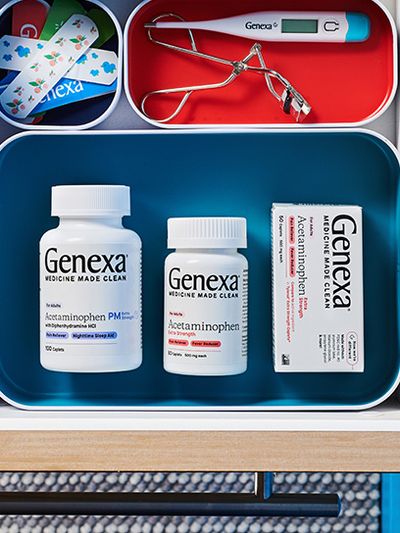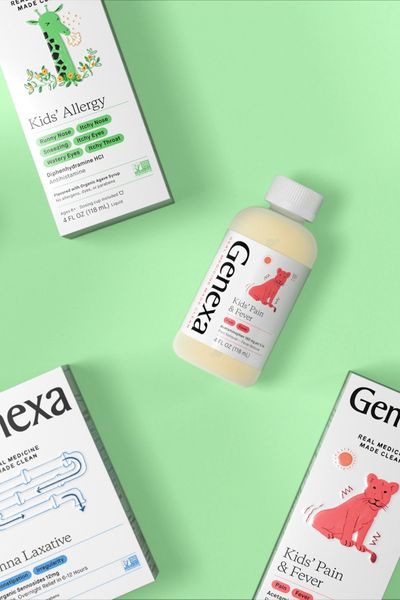Why Are GMO Ingredients Included In OTC Medicine?
GMO Ingredients: A Scientific Breakdown
Table of contents:
Reading the label of an over the counter (OTC)) medicine can feel overwhelming, particularly when reading the list of inactive ingredients. Today, some medicines are labeled “GMO-free,” but if you aren’t sure what GMOs are and why you might want to consider avoiding them, you’re not alone.
Before deciding whether or not to avoid medicines that include GMO ingredients, here’s what you need to know.
What are inactive ingredients?
The U.S. Food and Drug Administration (FDA) defines active ingredients as any component of a drug product that is intended to furnish pharmacological activity or other direct effect in the diagnosis, cure, mitigation, treatment, or prevention of disease, or to affect the structure or any function of the body of humans or animals in 21 Code of Federal Regulations (CFR) 210.3(b)(7).
Inactive ingredients are defined by the FDA under 21 CFR 210.3(b)(8) as any component of a drug product other than the active ingredient. Inactive ingredients provide many important characteristics to prescription drugs and over the counter medications, including contributing to the look, feel, and taste of a medication.
Inactive ingredients make up the vast majority of most medications, with about 75 percent of the average OTC medicine consisting of inactive ingredients.
According to Harvard Medical School, the average medication, including both OTC medicine and prescription medicine, contains about nine different inactive ingredients, with some drugs containing quite a few more and others much less.
Why are inactive ingredients included in OTC medicine?
Inactive ingredients play many important roles in OTC medicine and prescription medications alike.
Making up nearly three quarters of the average medication, inactive ingredients serve purposes that include:
- Helping the body to absorb the drug more easily by combining with an easily digestible substance like a fatty acid
- Slowing the absorption rate of a medication
- Binding the ingredients together to give the medicine a cohesive shape
- Extending the shelf life of a medication by preventing the growth of fungi and bacteria
- Making a medication taste better by masking the bitterness of active ingredients
Inactive ingredients do not play a role in treating or improving the symptoms of any medical condition, but they are still critically important in most medications. While not all medications contain inactive ingredients, the vast majority do contain inactive ingredients because they would not be able to work properly or maintain their form without them.
Many active ingredients have a bitter medicinal taste that would make them non-consumable by the average person without the addition of inactive ingredients, or they would dissolve too quickly to provide a therapeutic benefit, or they would have a short shelf life that would make them difficult to sell.
When formulating a medication, manufacturers use inactive ingredients for many different reasons, including:
- To coat the surface of tablets, pills, and capsules to make them easier to swallow and less bitter
- To stabilize the active ingredients prior to ingestion
- To ensure that your body can absorb the medication effectively
- To act as binders between the active ingredients of the medication
- To enhance the flavor of the medication to make it easier to swallow
- To improve the appearance of the medication by adding color to make it more palatable
- To help the medication dissolve at the proper time in the digestive tract
- To extend the shelf life of the medication by preventing the growth of fungi and bacteria
- To act as buffers
- To act as a filler to increase the mass of the medication, making it easier to handle
Inactive ingredients largely determine the final shape, color, size, and taste of the prescription drugs and OTC medications you have in your home. While some inactive ingredients always function as inactive ingredients no matter how they are used, others may be inactive ingredients in some contexts and active ingredients in others. One such ingredient that can serve as either an active ingredient or an inactive ingredient is alcohol. Some inactive ingredients are classified as genetically modified organisms, or GMOs.
What are GMO ingredients?
GMOs include plants, animals, microorganisms or other organisms who have had their genetic makeup altered in a laboratory setting using either genetic engineering or transgenic technology. GMOs have characteristics that could not naturally occur in nature or as a result of traditional cross breeding methods. Viruses, plants, animals, and bacteria can all be modified as GMOs.
Most people are familiar with GMO ingredients in the context of food because GMOs are commonly grown as commodity crops. Only a few GMO crops are widely available, but they are linked to a large number of ingredients, many of which are included in OTC medicines.
Inactive ingredients that may be sourced from GMO crops include:
- Amino acids
- Aspartame
- Sodium ascorbate
- Sodium citrate
- Natural and artificial flavors
- Hydrolyzed vegetable protein
- Maltodextrins
- Monosodium glutamate (MSG)
- Textured vegetable protein (TVP)
- Vitamins
- Yeast products
- Alcohol
- Ascorbic acid
- Citric acid
- Ethanol
- High fructose corn syrup
- Lactic acid
- Molasses
- Sucrose
- Xanthan gum
- Vinegar
GMO products are classified based on their potential to cause adverse health effects into four different risk levels: high risk, low risk, monitored risk, and non-risk. These risk levels help to identify products that are commonly used in foods, beverages, and medications that may pose a risk to consumer health and safety.
High risk
High risk products are those that are cultivated by organisms that are known to be genetically modified and are widely available from a commercial standpoint. Examples of high risk products include alfalfa, corn, papaya, sugar beet, zucchini, microbes, potatoes, canola, cotton, soy, yellow summer squash, animal products, and enzymes.
Low risk
Low risk ingredients include products where the input is not derived from, does not contain derivatives of, or is not produced through a process involving organisms that are presently known to be genetically modified and commercially available. Examples of low risk products include lentils, tomatoes, avocados, spinach, and sesame seeds.
Monitored risk
Products that are newly genetically engineered and have the potential to be widespread or contain evidence of contamination from GMOs are classified as modified risk. Examples of moderate risk GMOs include flax, rice, apples, oranges, camelina (false flax) tomato, mustard, wheat, mushrooms, pineapples, and sugarcane.
Non-risk
Ingredients that are not derived from living organisms and are not susceptible to genetic modification are classified as non-risk.
Why are GMO ingredients included in OTC medicine?
GMO ingredients are commonly included in OTC medicine as inactive ingredients. Manufacturers include these ingredients because they may be less expensive and are considered more hardy than other ingredients.
GMO ingredients that are commonly included in OTC medicine include:
- Aspartame
- Sodium ascorbate
- Sodium citrate
- Natural and artificial flavors
- Maltodextrins
- Monosodium glutamate (MSG)
- Yeast products
- Alcohol
- Ascorbic acid
- Citric acid
- Ethanol
- High fructose corn syrup
- Sucrose
- Xanthan gum
How does the use of GMO ingredients differ between agricultural and pharmaceutical use?
Most people who are familiar with GMOs are familiar with the use of these ingredients in an agricultural context. GMO crops are engineered to be more resistant to herbicides, insects, and other pests, which means that many farmers prefer them because the use of GMOs makes their livelihoods more stable.
In the pharmaceutical industry, GMOs are commonly used as inactive ingredients and for medicinal research because changes to their physical biochemistry has made them more suitable to use in medications according to some researchers.
Regardless of whether an organism is used for agricultural purposes or pharmaceutical purposes, researchers evaluate the suitability of GMOs using a number of different screening processes.
GMOs that are intended for agricultural use should demonstrate useful traits that help the plant to become more hardy without causing undue harm to humans or the environment.
GMOs that are intended for pharmaceutical use should demonstrate promise in the treatment of specific diseases or conditions.
Regardless of whether a GMO is intended for agricultural use or pharmaceutical use, the engineered genes that have been isolated by researchers will be inserted into the host organisms and plants for use in the real world.
How is the use of GMOs in medication regulated?
In the United States, the U.S. Food and Drug Administration (FDA) is responsible for regulating the use of GMOs in medication. The FDA tests GMOs for allergenicity, digestibility, and toxicity. However, despite the FDA’s role in regulating GMOs, there is still very little research that conclusively shows whether or not GMOs are safe for human consumption.
No long term studies have been done that evaluate the effects of GMOs on humans when the substances are consumed regularly.
A peer-reviewed study found that roughly equal numbers of scientists expressed concerns over the safety of GMOs as those who felt that GMOs are safe for human consumption. Therefore, many people have concerns about the inclusion of GMO ingredients in OTC medicine.
Summary
GMO ingredients in OTC medicine are genetically modified organisms that are included in medicine as inactive ingredients. Inactive ingredients serve a number of different purposes in medications, including improving the flavor, color, and texture of a drug, acting as a binding or dissolving agent, or changing the way a medication is absorbed by the body.
While many researchers claim that GMOs are safe or even beneficial, a growing number of scientists have expressed concerns about the safety of GMOs based on the absence of long term studies that examine the potential adverse effects of these ingredients.






